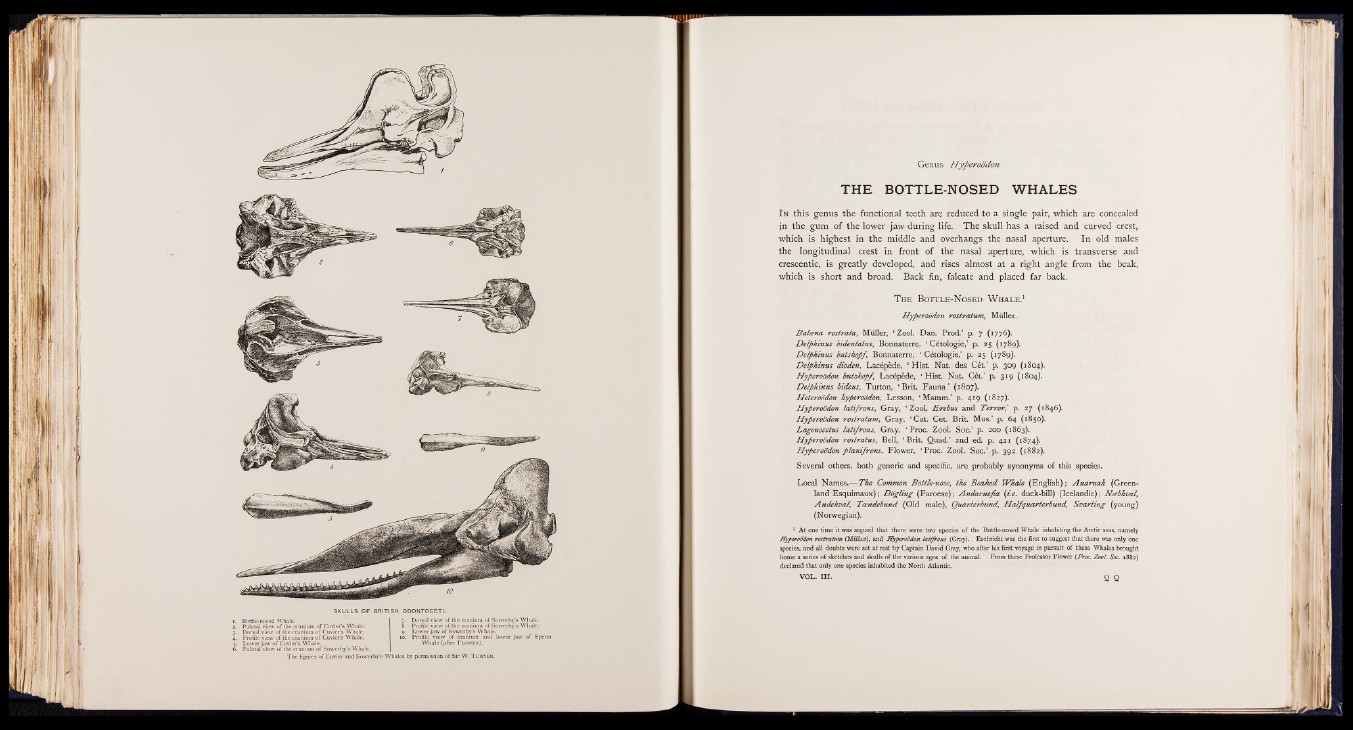
1I M■ ■ l w? S “mmWm i
Genus Hyperoödon
T H E B O T T L E -N O S E D W H A L E S
In this genus the functional teeth are reduced to a single pair, which are concealed
in the gum of the lower jaw during life. The skull has a raised and curved crest,
which is highest in the middle and overhangs the nasal aperture. In old males
the longitudinal crest in front of the nasal aperture, which is transverse and
crescentic, is greatly developed, and rises almost at a right angle from the beak,
which is short and broad. Back fin, falcate and placed far back.
T he Bottle-Nosed W hale.1
Hyperoödon rostratum, Muller.
Balcena rostrata, Müller, ‘ Zool. Dan. Prod.’ p. 7 (1776).
D elphinus bidentatus, Bonnaterre, ‘ Cytologie,’ p. 25 (1789).
Delphinus butskopf, Bonnaterre, ‘ Cytologie,’ p. 25 (1789).
Dclphinus dioden, Lacepede, ‘ Hist. Nat. des C£t.’ p. 309 (1804).
Hyperoödon butzkopf Lacepede, ‘ Hist. Nat. C 6t.’ p. 319 (1804).
D elphinus bidens, Turton, ‘ Brit. F au n a ’ (1807).
Heteroödon hyperoödon, Lesson, ‘ Mamm.’ p. 419 (1827).
Hyperoödori la tifron s, Gray, ‘ Zool. E rebus and Terror,’ p. 27 (1846).
Hyperoödon rostratum, Gray, ‘ Cat. Cet. B r it Mus.’ p. 64 (1850).
Lagenocetus la tifron s, Gray, ‘ Proc. Zool. Soc.’ p. 200 (1863).
Hyperoödon rostratus, Bell, ‘ Brit. Quad.’ 2nd ed. p. 421 (1874).
Hyperoödon p lan ifron s, Flower, ‘ Proc. Zool. Soc.’ p. 392 (1882).
Several others, both generic and specific, are probably synonyms o f this species.
Local Names.— T he Common Bottle-nose, the B ea ked Whale (English); A nam a k (Greenland
Esquimaux); D ögling (Faroese); A ndam efia ( ie . duck-bill) (Icelandic); Ncebhval,
Andehval, Teen debund (Old male), Quarterbund, H alfquarterbund, Svarting (young)
(Norwegian).
1 At one time it was argued that there were two species of the Bottle-nosed Whale inhabiting the Arctic seas, namely
Hyperoödon rostratum (Müller), and Hyperoödon. latifrons (Gray). Eschricht was the first to suggest that there was only one
species, and all doubts were set at rest by Captain David Gray, who after hjs first, voyage in pursuit of these Whales brought
home a series of sketches and skulls of the various ages of the animal. From these Professor Flower (Proc. Zool. Soc. 1882)
declared that only one species inhabited the North Atlantic.
VOL. III. Q Q
ii